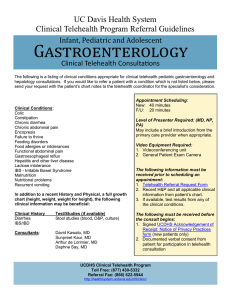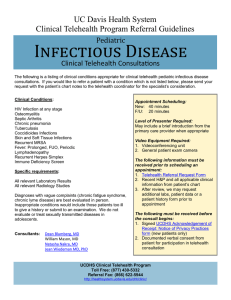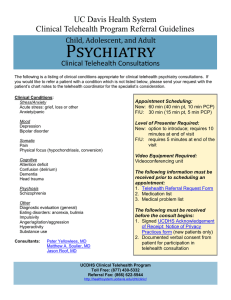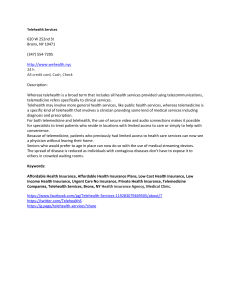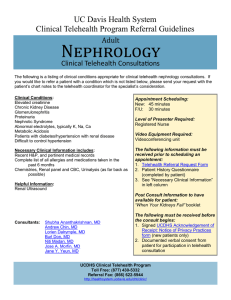Pediatric Telehealth Landscape: Current Practices & Research
advertisement
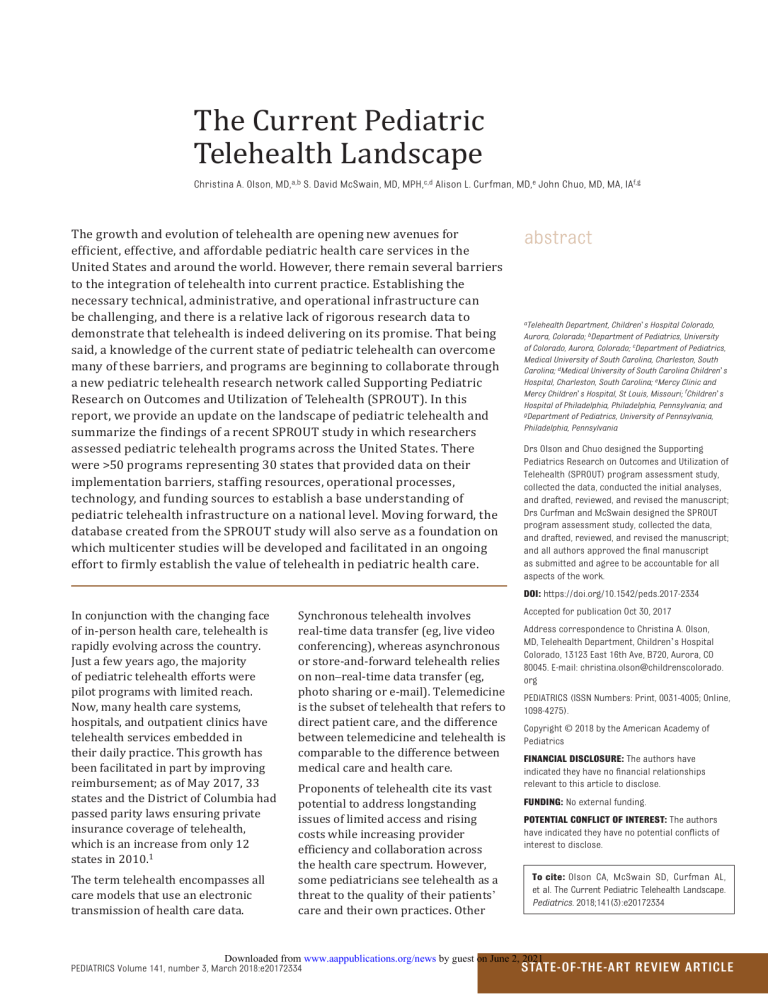
The Current Pediatric Telehealth Landscape Christina A. Olson, MD,a,b S. David McSwain, MD, MPH,c,d Alison L. Curfman, MD,e John Chuo, MD, MA, IAf,g The growth and evolution of telehealth are opening new avenues for efficient, effective, and affordable pediatric health care services in the United States and around the world. However, there remain several barriers to the integration of telehealth into current practice. Establishing the necessary technical, administrative, and operational infrastructure can be challenging, and there is a relative lack of rigorous research data to demonstrate that telehealth is indeed delivering on its promise. That being said, a knowledge of the current state of pediatric telehealth can overcome many of these barriers, and programs are beginning to collaborate through a new pediatric telehealth research network called Supporting Pediatric Research on Outcomes and Utilization of Telehealth (SPROUT). In this report, we provide an update on the landscape of pediatric telehealth and summarize the findings of a recent SPROUT study in which researchers assessed pediatric telehealth programs across the United States. There were >50 programs representing 30 states that provided data on their implementation barriers, staffing resources, operational processes, technology, and funding sources to establish a base understanding of pediatric telehealth infrastructure on a national level. Moving forward, the database created from the SPROUT study will also serve as a foundation on which multicenter studies will be developed and facilitated in an ongoing effort to firmly establish the value of telehealth in pediatric health care. In conjunction with the changing face of in-person health care, telehealth is rapidly evolving across the country. Just a few years ago, the majority of pediatric telehealth efforts were pilot programs with limited reach. Now, many health care systems, hospitals, and outpatient clinics have telehealth services embedded in their daily practice. This growth has been facilitated in part by improving reimbursement; as of May 2017, 33 states and the District of Columbia had passed parity laws ensuring private insurance coverage of telehealth, which is an increase from only 12 states in 2010.1 The term telehealth encompasses all care models that use an electronic transmission of health care data. Synchronous telehealth involves real-time data transfer (eg, live video conferencing), whereas asynchronous or store-and-forward telehealth relies on non–real-time data transfer (eg, photo sharing or e-mail). Telemedicine is the subset of telehealth that refers to direct patient care, and the difference between telemedicine and telehealth is comparable to the difference between medical care and health care. Proponents of telehealth cite its vast potential to address longstanding issues of limited access and rising costs while increasing provider efficiency and collaboration across the health care spectrum. However, some pediatricians see telehealth as a threat to the quality of their patients’ care and their own practices. Other abstract aTelehealth Department, Children’s Hospital Colorado, Aurora, Colorado; bDepartment of Pediatrics, University of Colorado, Aurora, Colorado; cDepartment of Pediatrics, Medical University of South Carolina, Charleston, South Carolina; dMedical University of South Carolina Children’s Hospital, Charleston, South Carolina; eMercy Clinic and Mercy Children’s Hospital, St Louis, Missouri; fChildren’s Hospital of Philadelphia, Philadelphia, Pennsylvania; and gDepartment of Pediatrics, University of Pennsylvania, Philadelphia, Pennsylvania Drs Olson and Chuo designed the Supporting Pediatrics Research on Outcomes and Utilization of Telehealth (SPROUT) program assessment study, collected the data, conducted the initial analyses, and drafted, reviewed, and revised the manuscript; Drs Curfman and McSwain designed the SPROUT program assessment study, collected the data, and drafted, reviewed, and revised the manuscript; and all authors approved the final manuscript as submitted and agree to be accountable for all aspects of the work. DOI: https://doi.org/10.1542/peds.2017-2334 Accepted for publication Oct 30, 2017 Address correspondence to Christina A. Olson, MD, Telehealth Department, Children’s Hospital Colorado, 13123 East 16th Ave, B720, Aurora, CO 80045. E-mail: christina.olson@childrenscolorado. org PEDIATRICS (ISSN Numbers: Print, 0031-4005; Online, 1098-4275). Copyright © 2018 by the American Academy of Pediatrics FINANCIAL DISCLOSURE: The authors have indicated they have no financial relationships relevant to this article to disclose. FUNDING: No external funding. POTENTIAL CONFLICT OF INTEREST: The authors have indicated they have no potential conflicts of interest to disclose. To cite: Olson CA, McSwain SD, Curfman AL, et al. The Current Pediatric Telehealth Landscape. Pediatrics. 2018;141(3):e20172334 Downloaded from www.aappublications.org/news by guest on June 2, 2021 PEDIATRICS Volume 141, number 3, March 2018:e20172334 State-of-the-Art Review Article concerns include uncertainty over liability, credentialing and licensing procedures, reimbursement, and a relative lack of rigorous research on the quality and value of pediatric telehealth when compared with in-person care. Pediatric telehealth programs across the United States and around the world have historically grown individually rather than in a cohesive fashion, which makes it difficult to address these concerns in an evidence-based manner. Efficacy data exist for some telehealth models,2,3 but system variations among programs make it difficult to generalize results. To address this gap, a national pediatric telehealth research network, Supporting Pediatric Research on Outcomes and Utilization of Telehealth (SPROUT), was established in 2015. SPROUT currently has members from >75 health organizations in 3 countries and aims to gather data on existing pediatric telehealth services and facilitate multicenter trials. This State of the Art Review includes new data from SPROUT’s national assessment of health care organizations that provide telehealth and in-person care to pediatric patients, informs readers as to the current state of telehealth practice, and provides a base for the ongoing development of pediatric telehealth in the future. Background Exponential telehealth growth is occurring across the continuum of health care. This growth can be attributed to improvements in technology and Internet connectivity, a business environment that supports innovation, and an increasing emphasis on convenient and valuebased health care.4 However, rapid growth has led to implementation difficulties because updates to regulations, laws, and payment structures tend to lag behind 2 advances in telehealth services and technology. Despite these challenges, telehealth has already become more common than pediatricians may realize. Remote interpretation of radiology studies and secure e-mail systems that connect health care team members are ubiquitous forms of telehealth, and their acceptance has enabled the development of new health care models, such as live patient-provider video encounters. Current pediatric telehealth programs span a wide spectrum of use cases, including acute-care visits at day care centers, pretransport assessment and stabilization of critically ill children at community hospitals, remote monitoring of patients in their homes, and subspecialty consultations that support primary-care pediatricians in remote areas.5– 7 One pediatric program recently demonstrated a 125% growth in online visits and an 88% increase in parents’ awareness of telemedicine services over just the past 3 years.8 Global health programs also increasingly leverage telehealth to connect health care professionals and patients around the world. Their services run the gamut from remote faculty mentorship for trainees in other countries to pediatric cardiac intensive care consults from thousands of miles away.9,10 Although the general concepts discussed below also apply to global health programs, international telehealth services have innately different regulatory considerations and added logistical challenges, such as language and time-zone barriers. Practice Principles and Regulations Two principles underlie all forms of telehealth: (1) the standard of care for any given condition is the same regardless of whether care is provided in person or via telehealth, and (2) the site of care is the patient’s physical location at the time of the telehealth encounter. Although these principles seem straightforward, their application is more nuanced. In-person care is based on the premise that patients will travel to their providers’ location, so hospitals and clinics tend to focus their attention on the regulations that are in effect in their cities. They may not realize that different regulations can apply at their telehealth sites. In some places, coding requirements for in-person care have also become part of care standards although they exist primarily for billing and data collection. These coding requirements may not be applicable to telehealth services even if the services still meet the standard of care. For example, if a 24-week preterm infant is unexpectedly born at a hospital with a level I nursery, a primary-care pediatrician often has responsibility for the initial management. Early data suggest that having a neonatologist consulting via video conference may add value to the patient’s care at the community-hospital site,11 although the teleneonatologist’s assessment may be limited by technical factors, and he or she will not meet the in-person requirement for billing the newborn resuscitation Current Procedural Terminology code. In this example, the standard of care for both the community pediatrician and the teleneonatologist is not the care that the infant would receive from a neonatologist at a tertiarycare facility but rather the care that the infant would receive at a level I nursery with a neonatologist who is only available by telephone. The patient’s location during a telehealth encounter also has implications for licensing and privileging. With rare exceptions, pediatricians need a state license and hospital privileges (if the patient is in a hospital or hospital-based clinic) at a patient’s location before providing telemedicine care. This adds to the administrative burden for services Downloaded from www.aappublications.org/news by guest on June 2, 2021 Olson et al that cross state lines or support unaffiliated hospitals, but it also lets pediatricians manage their patients from anywhere by using telehealth as long as the patients are in their home states. Example 1: If a Colorado-licensed neurologist wants to evaluate a child with seizures in a Kansas hospital via telehealth, he or she needs a Kansas license and hospital privileges at the patient’s location. All Kansas state laws and regulations apply to the encounter rather than those of Colorado. Example 2: If a South Carolina– licensed pediatrician is traveling in Pennsylvania, he or she can see patients in South Carolina via telehealth without needing a Pennsylvania license. Malpractice coverage and liability jurisdiction are the only regulatory issues in which both the patient and provider locations can matter. Many malpractice policies for in-person care also include telehealth, but pediatricians who are contemplating new or expanded telehealth services should verify that their policies cover the planned telehealth service at both the provider’s and the patient’s location. Fortunately, malpractice cases directed at telehealth providers have, thus far, been rare. The American Telemedicine Association recently published Operating Procedures for Pediatric Telehealth, which were endorsed by the American Academy of Pediatrics (AAP).12 These operating procedures, in conjunction with the AAP’s Policy Statement and Technical Report on telehealth,13,14 help pediatricians develop local practice guidelines that may reduce their exposure to malpractice lawsuits. Policies The Health Insurance Portability and Accountability Act (HIPAA) of 199615 and the Health Information Technology for Economic and Clinical Health Act16 are the 2 key federal laws that apply to pediatric telehealth. These laws set forth privacy and security requirements for the electronic transmission of protected health information during telehealth services. National telehealth guidance is also published annually by the Centers for Medicare and Medicaid Services,17 and the recent introduction of new federal legislation, such as the Creating Opportunities Now for Necessary and Effective Care Technologies for Health Act of 2017,18 could significantly impact the telehealth environment in the near future. The Creating Opportunities Now for Necessary and Effective Care Technologies for Health Act would allow Medicare programs to waive restrictions that currently limit telehealth usage, including restrictions on allowable originating sites, store-and-forward technologies, remote patient monitoring, and eligible telehealth providers. Although federal telehealth policies and legislation largely pertain to Medicare, certain populations of medically complex children, such as those with end-stage renal disease, are directly impacted by these policies. Additionally, changes to Medicare reimbursement often inform decisions made by Medicaid programs and commercial payers. Currently, state laws and regulations affect pediatric telehealth programs more than national guidance. These include licensing board requirements, Medicaid policies, and laws that dictate commercialpayer coverage. Unfortunately, there is little uniformity among states’ telehealth policies, and policies in the same state can differ. For example, a Medicaid program may cover home-based telehealth, but commercial payers in the same state only need to cover telehealth for patients in a health care facility. The details of each state’s policies are beyond the scope of this article, but the Center for Connected Health Policy maintains a Web site that lists state-by-state laws and regulations, including pending legislation and Medicaid policies.19 The Telehealth Resource Centers are another good source for region-specific information.20 Reimbursement In states without laws that mandate coverage for telehealth, payers can restrict or encourage telehealth growth. Some have already established comprehensive policies regarding telehealth, and others are willing to negotiate payment for telehealth services with individual health care organizations or patients. However, there are markets in which telehealth is limited by a lack of reimbursement or reimbursement at lower rates than comparable in-person services. Because of the wide variation in payer plans, pediatricians should recommend that families verify their coverage for telehealth services if their payers will be billed. It is important to understand that there are many models of telehealth practice, and a payer’s assessment of a telehealth service’s value will vary depending on the target population and specific model. Some studies have demonstrated clear cost savings with telehealth compared with in-person care, whereas a few recent reports have suggested that telehealth can cost the health system more even when it reduces per-encounter costs.21– 23 For example, telehealth services that focus primarily on convenience (such as low-acuity, on-demand care in a patient’s home) may increase use without a commensurate decrease in overall costs to a payer. Services that improve the management of chronic conditions, reduce interhospital transfers, or shift care away from higher-cost locations, such as the emergency department, are more Downloaded from www.aappublications.org/news by guest on June 2, 2021 PEDIATRICS Volume 141, number 3, March 2018 3 likely to have a positive impact on overall cost. However, direct payer reimbursement is not the only factor that affects a telehealth program’s return on investment. Services that add market share or increase efficiency within a health care organization can be highly valuable in non–fee-for-service models. Accountable Care Organizations, bundled payments, capitated plans, concierge medicine, and highdeductible plans all impact telehealth use and growth by shifting financial risks and incentives from payers to patients and providers. This shift is encouraging clinical care models with lower overall costs (for example, telemedicine visits rather than in-person outreach clinics with physician travel costs) and increased patient convenience (such as smartphone-based acute care in the home). TABLE 1 Geographic Reach of Telehealth Programs No. programs % of programs Regional Statewide Multistate Nationwide 22 35 10 20 14 29 8 16 Technology The type of technology used by each pediatric telehealth program depends on goals, clinical services, and capital investment availability. Although up-front costs may receive the most attention, a program’s sustainability depends on the ability to support staffing requirements, maintain equipment, and update technology over time. Hospital- and clinic-based telehealth services often purchase fixed equipment (such as video cameras, microphones, and video screens in rooms that are equipped for tele-ICU monitoring) or mobile carts with integrated telehealth equipment. Home-based services, on the other hand, typically use patients’ personal devices, such as smartphones and home computers. Telehealth services with more physical examination components may also require peripheral devices, such as digital stethoscopes, otoscopes, or highresolution handheld cameras. The AAP’s Section on Telehealth Care 4 FIGURE 1 Specialty services offered by pediatric telehealth programs. is currently spearheading an effort called the Section on Telehealth Care Affinity Program to evaluate technology that is well suited and cost-effective for primary-care practices without existing telehealth program infrastructure. Remote home monitoring requires separate technology that is often designed for specific use cases. Patients can purchase or borrow a wide variety of devices that transmit data, such as weight, blood pressure, pulse oximetry, electrocardiogram waveform, and glucose, in real time or at preset intervals. Pediatricians who supervise remote homemonitoring services should have reliable procedures for a timely review of the data, protocols for responding to abnormalities, and accurate contact information for communicating results and action plans with patients. Software is just as essential to a telehealth program’s success as the physical devices. Software programs can automatically connect pediatricians and patients at different sites, link devices to electronic medical records (EMRs), provide decision-support algorithms, and Downloaded from www.aappublications.org/news by guest on June 2, 2021 Olson et al facilitate data collection and analysis. To ensure HIPAA compliance, a health care organization should obtain a business associate agreement from software companies if it purchases software that will transmit or store identifiable patient data. Mobile applications are a unique type of software, with some being marketed directly to families and others being designed to support clinicians. Pediatricians should be aware that there are no regulations mandating applications’ clinical accuracy, and few are designed for young children. For these reasons, applications should be tested before recommending them to patients. At a minimum, a primary-care pediatrician using telehealth will need high-speed Internet connectivity, access to a HIPAAcompliant platform for video conferencing or other data transmission, and a networked device (such as a computer with a webcam and speakers). Comprehensive telehealth carts are also available and typically cost $10 000 to $35 000 (US dollars) depending on the quality of the camera and added peripheral devices. Leased equipment tends to be more expensive over time but often includes technical support and maintenance. Large telehealth programs might be willing to facilitate purchases for smaller programs, but they cannot transfer ownership of telehealth equipment to referring providers for free or at a discounted price because of Stark Law. Stark Law includes federal statutes that prevent health care organizations from providing financial incentives (such as free technical equipment) to unaffiliated providers to increase their referral volume; violators must return Medicare and/or Medicaid payments that stem from inappropriate referrals and are subject to financial penalties.24 FIGURE 2 Pediatric telehealth program funding sources. FIGURE 3 Initial institutional investment in pediatric telehealth programs. Because of multiple factors that affect telehealth’s feasibility, utility, and financial viability, it is impossible to provide a single roadmap for new telehealth programs. However, there are system factors that increase the likelihood of success. In the remainder of this article, we present data from a recent, national assessment of existing pediatric telehealth programs in the United States to guide pediatricians who are planning new or expanded telehealth services. National Program Assessment Data Between October 2016 and March 2017, SPROUT team members conducted a survey to assess the current state of pediatric telehealth programs across the United States. In this comprehensive study, researchers assessed several domains, including program demographics, 57 clinical service lines, operational infrastructure, funding, and barriers to implementation. Questions related Downloaded from www.aappublications.org/news by guest on June 2, 2021 PEDIATRICS Volume 141, number 3, March 2018 5 to operational infrastructure were divided into 3 system categories: human resources, operation processes, and technological tools. The 210 survey questions were arranged in branching logic, underwent iterative review and revision by SPROUT project team members, and were finalized via project team consensus. The survey was sent to 1 representative from each US-based health care organization in SPROUT’s pediatric telehealth program database, which was assembled through networking at 3 national conferences over 2 years and outreach by using professional society listservs. Additional recruitment occurred via an invitation letter sent to all pediatric residency program chairs to capture other health care organizations with large volumes of pediatric patients. Of the 76 surveys that were distributed, 56 were returned (74% response rate), with 30 states represented. Most responses came from academic medical centers, which may have skewed the data toward larger telehealth programs, but a few private-practice clinics, governmental, and nonprofit organizations also responded. Another limitation of these data is a preponderance of responses from established telehealth programs, which may not adequately reflect the barriers affecting pediatricians who are new to telehealth. The demographical results were reported via descriptive statistics and visualized via Pareto charts. Negative binomial regression univariate analyses were done to identify potential factors for future, in-depth exploration associated with the number of established programs for a given institution; covariates were 15 human resource types, 14 processes, the total number of human resource types, and the total number of formal operation processes. 6 FIGURE 4 Internet connection types. FIGURE 5 Operating systems. iOS, iPhone operating system; OS, operating system. FIGURE 6 Peripheral devices in use. Although analysis did not include interaction terms nor did it adjust for potential cofounders, more stringent Bonferroni correction was used to counteract the problem of multiple comparisons. An analysis of reported barriers was severity weighted, with 1 point assigned if the program Downloaded from www.aappublications.org/news by guest on June 2, 2021 Olson et al described it as a minor barrier and 2 points for barriers that were described as major. Demographics and Clinical Services Most of the responding organizations served both pediatric and adult patients. Twenty-two sites (40%) had dedicated pediatric programs, and 29 (53%) reported combined programs for pediatric and adult telehealth. Four additional programs (7%) had no current telehealth services but provided information on their barriers to implementation and program infrastructure. Table 1 describes the geographic reach of each responding telehealth program within the United States. Sixteen of these programs (33%) also provide pediatric telehealth services internationally. The 52 active programs reported a wide variety of established clinical services, with many also reporting services in the pilot phase. This suggests rapid, ongoing growth of pediatric telehealth on a national level. Figure 1 lists the specialty services currently offered by survey respondents to describe the breadth of pediatric telehealth in the United States, with the top 5 established service lines being neurology, psychiatry, cardiology, neonatology, and critical care. Other commonly reported pediatric telehealth services included nutrition (40% of the programs), psychology (38%), language interpretation (25%), child life (21%), and remote home monitoring (19%). The AAP is also developing a comprehensive database of pediatric telehealth programs to support pediatricians in the United States. This database will include a list of telehealth services at each organization and should be available to the public in late 2017 or 2018. Program Characteristics (Staffing, Processes, and Funding Sources) Telehealth programs responding to the assessment survey FIGURE 7 Barriers to startup or growth for pediatric telehealth programs. Originating site refers to the patient’s location during a telehealth encounter; distant site refers to the provider’s location during a telehealth encounter. FIGURE 8 Key barriers affecting telehealth program startup and expansion. Originating site refers to the patient’s location during a telehealth encounter; distant site refers to the provider’s location during a telehealth encounter. described various reporting structures. The majority reported only to clinical leadership (52%), but some programs reported to administration only (27%), both clinical leadership and administration (15%), information technology only (2%), or a combination of all 3 (4%). Individual staffing models varied, but the top 5 positions with dedicated time to support telehealth were the director, manager, medical director, technical staff, and credentialing staff. The position types that were least likely to have dedicated telehealth time were the mobile application developer, quality improvement (QI), research, EMR analyst, and risk management. This is concerning because many national telehealth leaders anticipate that mobile applications with EMR interfaces will become increasingly prominent, and organizations need QI and research data to assess Downloaded from www.aappublications.org/news by guest on June 2, 2021 PEDIATRICS Volume 141, number 3, March 2018 7 their programs’ quality of care and value. Of responding programs, >70% had formal processes for managing technical problems, ensuring compliance with regulations, providing telemedicine education, vetting and implementing new services, and billing and/or budgeting. By using negative binomial regressions univariate analysis, the presence of a telehealth director (P < .04), manager (P < .004), technical staff (P < .004), clinical champion at remote sites (P < .0003), and an overall steering committee (P < .02) was significantly associated with an increase in the number of services offered by a telehealth program. Additionally, the presence of formal processes to manage technical problems (P = .0002), ensure regulatory compliance (P ≤ .0009), manage finances (P < .0001), ensure provider competency (P < .009), evaluate existing services (P < .003), access legal counsel (P < .008), develop contracts (P < .0001), and support QI projects (P < .03) was significantly associated with the number of telehealth services. Institutional direct funding (P < .0001) was also associated with the number of telehealth services. After Bonferroni correction, the presence of clinical champions at remote sites and processes to manage technical problems, manage finances, ensure regulatory compliance, and develop contracts remained significant. Although the survey data do not demonstrate a causal effect, these findings may assist new or growing programs as they allocate resources. Programs that completed this survey are primarily supported financially by direct institutional investment (Figs 2 and 3), although the data may have been skewed by a preponderance of responses from larger medical centers. Figure 2 also shows that 8 pediatric telehealth programs rely on multiple funding sources, with fee-for-service professional billing only representing 1 portion. This survey was limited in that it did not assess indirect financial benefits of telehealth programs, such as market share growth. Additional referrals, lower transfer rates to other hospitals, and decreased costs are difficult to quantify but may be key financial factors for telehealth programs.25 Technology Pediatric telehealth programs reported using a wide variety of networked technical devices, with many using several types: desktop computers (79% of respondents), laptops (70%), integrated telemedicine carts (70%), tablets (61%), and smartphones (48%). Figures 4 and 5 demonstrate that hardwired Internet connections and Microsoft Windows–based devices are the most common, but Wi-Fi, cellular Internet connections, and mobile platforms are also prevalent. This mirrors a national trend toward mobile computing options in health care.26 Peripheral devices are also used by most pediatric telehealth programs to enhance remote physical examinations (Fig 6). In most cases, telehealth platforms were built by external vendors (58% of respondents), but 26% of programs reported that their platforms were custom built in-house, and another 16% replied that they were using a combination of vendor- and in-house–built telehealth platforms. Barriers Besides describing the existing state of programs, this survey identified barriers that are preventing the growth or expansion of pediatric telehealth in the United States. These barriers highlight key opportunities for advocacy efforts by pediatricians at the state and national levels and topics that health care organizations should evaluate and address locally before committing significant resources to new programs. Respondents reported that most of these barriers could be overcome but not without effort. Figure 7 describes the key barriers reported with data weighted for severity (1 point for minor barriers and 2 points for major barriers). Among the major barriers, licensing requirements, provider interest at patient (originating) sites, and a lack of resources to train providers were most likely to prevent the start-up of new programs, whereas reimbursement challenges were most likely to prevent expansion (Fig 8). Conclusions Pediatric telehealth can reach a wide array of pediatric populations with difficulty accessing health care because of geographic distance or resource limitations. As technology availability and evidence for telehealth models increase, the questions surrounding telehealth will become less about should pediatricians integrate telehealth into standard practices and more about how we can do it. Wide variations in funding, state regulation, insurance coverage, and health care business models have led to highly variable telehealth practices around the United States, but an increasing emphasis on collaborative implementation holds the promise for more efficient growth in the future. High-quality studies on the effectiveness and safety of pediatric telehealth practice are of paramount importance. Numerous studies have demonstrated telehealth’s feasibility and a high Downloaded from www.aappublications.org/news by guest on June 2, 2021 Olson et al level of satisfaction from patients, families, and providers,27,28 but rigorous multicenter studies are needed. The SPROUT collaborative has gained rapid, widespread support and participation around the country, and efforts are now underway to conduct multicenter trials. Barriers to the growth and development of pediatric telehealth programs are wide ranging, but technical challenges are usually less significant than provider-specific issues surrounding reimbursement, engagement, and available time. The demonstration of benefits to patient outcomes and provider efficiency are essential to increasing the use of telehealth services. Efforts to improve reimbursement for telehealth services hinge on the demonstration of cost savings and improved outcomes to payers and legislators. Despite these limitations, pediatric telehealth has advanced significantly in the past 10 years and is no longer an experimental concept. As pediatricians, we must ensure that children consistently receive high-quality, high-value telehealth care in an efficient manner, but the potential is almost limitless, and implementation is becoming easier each year. Abbreviations AAP: A merican Academy of Pediatrics EMR: electronic medical record HIPAA: H ealth Insurance Portability and Accountability Act QI: quality improvement SPROUT: Supporting Pediatric Research on Outcomes and Utilization of Telehealth References 1.American Telemedicine Association. State policy resource center. Available at: www.americantelemed.org/policy- page/state-policy-resource-center. Accessed June 29, 2017 2.Wang SK, Callaway NF, Wallenstein MB, Henderson MT, Leng T, Moshfeghi DM. SUNDROP: six years of screening for retinopathy of prematurity with telemedicine. Can J Ophthalmol. 2015;50(2):101–106 3.Wood CL, Clements SA, McFann K, Slover R, Thomas JF, Wadwa RP. Use of telemedicine to improve adherence to American Diabetes Association standards in pediatric type I diabetes. Diabetes Technol Ther. 2016;18(1):7–14 telemedicine consultation for newborn resuscitations: the Mayo Clinic experience. Mayo Clin Proc. 2016;91(12):1735–1743 12.Pediatric Telehealth Workgroup, American Telemedicine Association. ATA operating procedures for pediatric telehealth. Available at: https:// higherlogicdownload.s3.amazonaws. com/AMERICANTELEMED/618da447- dee1-4ee1-b941-c5bf3db5669a/ UploadedImages/NEW%20Practice%20 Guidelines/ATA%20Pediatric%20 Telehealth.final%20with%20 endorsements.pdf. Accessed July 6, 2017 4.Dorsey ER, Topol EJ. State of telehealth. N Engl J Med. 2016;375(2):154–161 13.Marcin JP, Rimsza ME, Moskowitz WB; Committee on Pediatric Workforce. The use of telemedicine to address access and physician workforce shortages. Pediatrics. 2015;136(1):202–209 5.McConnochie KM, Wood NE, Kitzman HJ, Herendeen NE, Roy J, Roghmann KJ. Telemedicine reduces absence resulting from illness in urban child care: evaluation of an innovation. Pediatrics. 2005;115(5):1273–1282 14.Burke BL Jr, Hall RW. Section on Telehealth Care. Telemedicine: pediatric applications. Pediatrics. 2015;136(1). Available at: www. pediatrics.org/cgi/content/full/136/1/ e293 6.Heath B, Salerno R, Hopkins A, Hertzig J, Caputo M. Pediatric critical care telemedicine in rural underserved emergency departments. Pediatr Crit Care Med. 2009;10(5):588–591 15.United States Department of Health and Human Services. HIPAA for professionals. Available at: https:// www.hhs.gov/hipaa/for-professionals/ index.html?language=es. Accessed June 29, 2017 7.Mahnke CB, Jordan CP, Bergvall E, Person DA, Pinsker JE. The Pacific Asynchronous TeleHealth (PATH) system: review of 1,000 pediatric teleconsultations. Telemed J E Health. 2011;17(1):35–39 8.HealthLeaders Media. Pediatric telemedicine poised for growth spurt. Available at: www.healthleadersmedi a.com/technology/pediatric- telemedicine-poised-growth-spurt#. Accessed July 9, 2017 9.Asturias EJ, Heinrichs G, Domek G, et al. The Center for Human Development in Guatemala: an innovative model for global population health. Adv Pediatr. 2016;63(1):357–387 10.Otero AV, Lopez-Magallon AJ, Jaimes D, et al. International telemedicine in pediatric cardiac critical care: a multicenter experience. Telemed J E Health. 2014;20(7):619–625 11.Fang JL, Collura CA, Johnson RV, et al. Emergency video 16.United States Department of Health and Human Services. HITECH Act enforcement interim final rule. Available at: https://www.hhs.gov/ hipaa/for-professionals/special-topics/ HITECH-act-enforcement-interim- final-rule/index.html?language=es. Accessed June 29, 2017 17.Center for Medicare and Medicaid Services, United States Department of Health and Human Services. Telehealth services. Available at: https://www.cms.gov/Outreach-and- Education/Medicare-Learning-Network- MLN/MLNProducts/downloads/ TelehealthSrvcsfctsht.pdf. Accessed June 29, 2017 18.Center for Connected Health Policy. Fact sheet: S.1016 Creating Opportunities Now for Necessary and Effective Care Technologies (CONNECT) act of 2017. Available at: www.cchpca.org/sites/default/ files/resources/S%201016%20 Downloaded from www.aappublications.org/news by guest on June 2, 2021 PEDIATRICS Volume 141, number 3, March 2018 9 CONNECT%20ACT%20FINAL.pdf. Accessed July 6, 2017 19.Center for Connected Health Policy. State laws and reimbursement policies. Available at: http://cchpca. org/state-laws-and-reimbursement- policies. Accessed June 29, 2017 20.Telehealth Resource Centers. Available at: www.telehealthresourcecenter.org/. Accessed June 29, 2017 21.Yang NH, Dharmar M, Yoo BK, et al. Economic evaluation of pediatric telemedicine consultations to rural emergency departments. Med Decis Making. 2015;35(6):773–783 22.Spaulding R, Belz N, DeLurgio S, Williams AR. Cost savings of 10 telemedicine utilization for child psychiatry in a rural Kansas community. Telemed J E Health. 2010;16(8):867–871 23.Ashwood JS, Mehrotra A, Cowling D, Uscher-Pines L. Direct-to-consumer telehealth may increase access to care but does not decrease spending. Health Aff (Millwood). 2017;36(3):485–491 24.Stark Law. Information on penalties, legal practices, latest news and advice. Available at: http://starklaw.org/. Accessed June 29, 2017 25.Dharmar M, Sadorra CK, Leigh P, Yang NH, Nesbitt TS, Marcin JP. The financial impact of a pediatric telemedicine program: a children’s hospital’s perspective. Telemed J E Health. 2013;19(7):502–508 26.Ventola CL. Mobile devices and apps for health care professionals: uses and benefits. P&T. 2014;39(5):356–364 27.McConnochie KM, Wood NE, Herendeen NE, ten Hoopen CB, Roghmann KJ. Telemedicine in urban and suburban childcare and elementary schools lightens family burdens. Telemed J E Health. 2010;16(5):533–542 28.Davis AM, James RL, Boles RE, Goetz JR, Belmont J, Malone B. The use of TeleMedicine in the treatment of paediatric obesity: feasibility and acceptability. Matern Child Nutr. 2011;7(1):71–79 Downloaded from www.aappublications.org/news by guest on June 2, 2021 Olson et al The Current Pediatric Telehealth Landscape Christina A. Olson, S. David McSwain, Alison L. Curfman and John Chuo Pediatrics 2018;141; DOI: 10.1542/peds.2017-2334 originally published online February 27, 2018; Updated Information & Services including high resolution figures, can be found at: http://pediatrics.aappublications.org/content/141/3/e20172334 References This article cites 17 articles, 3 of which you can access for free at: http://pediatrics.aappublications.org/content/141/3/e20172334#BIBL Subspecialty Collections This article, along with others on similar topics, appears in the following collection(s): Administration/Practice Management http://www.aappublications.org/cgi/collection/administration:practice _management_sub Health Information Technology http://www.aappublications.org/cgi/collection/health_information_te chnology_sub Telehealth Care http://www.aappublications.org/cgi/collection/telehealth_care_sub Permissions & Licensing Information about reproducing this article in parts (figures, tables) or in its entirety can be found online at: http://www.aappublications.org/site/misc/Permissions.xhtml Reprints Information about ordering reprints can be found online: http://www.aappublications.org/site/misc/reprints.xhtml Downloaded from www.aappublications.org/news by guest on June 2, 2021 The Current Pediatric Telehealth Landscape Christina A. Olson, S. David McSwain, Alison L. Curfman and John Chuo Pediatrics 2018;141; DOI: 10.1542/peds.2017-2334 originally published online February 27, 2018; The online version of this article, along with updated information and services, is located on the World Wide Web at: http://pediatrics.aappublications.org/content/141/3/e20172334 Pediatrics is the official journal of the American Academy of Pediatrics. A monthly publication, it has been published continuously since 1948. Pediatrics is owned, published, and trademarked by the American Academy of Pediatrics, 345 Park Avenue, Itasca, Illinois, 60143. Copyright © 2018 by the American Academy of Pediatrics. All rights reserved. Print ISSN: 1073-0397. Downloaded from www.aappublications.org/news by guest on June 2, 2021
